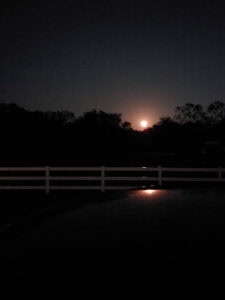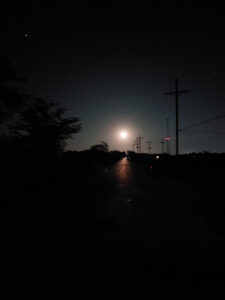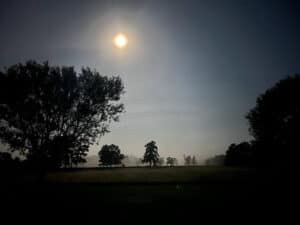Astronomy doesn’t usually interest me, but . . .
Full Moons
By definition, a full moon is when the side of the moon facing the earth is completely lit by the sun. It occurs about every 29.5 days. There are just over twelve complete moon cycles each year. Because the moon and sun aren’t in sync, extra full moons will appear in a season.
Though all full moons rise around sunset, not all look the same. Why, when nothing about the moon has changed? The difference stems from the moon’s distance to the earth and the atmosphere through which it’s seen. These factors can make the moon different colors or look larger or smaller.
Did You Know…
- A micro- or mini-moon is the smallest appearing full moon. It occurs when the distance between the moon and the earth is the greatest. A supermoon is the largest appearing full moon. It occurs when the moon is closest to the earth.
- In 1979, astrologer Richard Molle coined the term “supermoon.”
- A supermoon appears 30% brighter and 14% larger than a micro-moon.
- Your brain is fooling you when the full moon seen just over the horizon looks larger than normal. It’s called “the moon illusion,” and no one knows exactly what causes it.
- Seeing a red or orange moon near the horizon isn’t an illusion. It’s a physical effect. Bluer wavelengths of moonlight are filtered out by the earth’s atmosphere. The lower on the horizon the moon is, the thicker the atmosphere and the less blue light. This results in a red or orange-colored moon.
History
From the beginning, men have paid attention to the moon. Its phases and cycles signaled season changes, marking important times like planting, harvesting, and hunting. The Native Americans in North America tracked these seasons by giving the reoccurring full moons unique names. These names then identified individual months in a year.
Newly arrived Europeans settling in the area embraced the idea of naming full moons, often using the Native American’s names for them. These full moon names were spread by periodicals like The Farmer’s Almanac. The idea of naming full moons not only spread across North America but jumped the Atlantic and spread across Europe.
Did You Know…
- Full moon names usually characterized nature or a weather condition that happened around the time of that particular full moon.
- The Algonquin tribes, who lived between New England and Lake Superior, gave us the most well-known full moon names.
- Before European influences in the last several centuries, full moons weren’t named in the Southern Hemisphere.
- A few of the full moon names include blood moon, blue moon, and corn or barley moon.
- In the song, Colors of the Wind, from the Disney movie, Pocahontas, the words “blue corn moon” refer to a second full moon in September. September’s full moon is the corn moon, while the second full moon in a calendar month is widely known as a blue moon.
Harvest Moon
The “Harvest Moon” is another full moon name. But unlike the others, it isn’t based on the month in which it falls. Instead, it’s the full moon closest to the autumnal equinox, i.e., the start of autumn. For the northern hemisphere, this occurs in late September or early October.
It was called “Harvest Moon” because it coincided with harvest time, and the extra light it supplied so soon after sunset enabled farmers to continue gathering their crops late into the night.
Did You Know…
- A Harvest Moon can occur any time from two weeks before the autumnal equinox to two weeks after, which means it’s either the last summer or first autumn full moon.
- The effect of the Harvest Moon is greater the farther north you live. For example, the Harvest Moon will rise at almost the same time for a week in Anchorage, Alaska.
- Ancient folklore claims frost will not kill buds and blossoms if it happens in a Harvest Moon’s light.
- A Harvest Moon falls in March or April for farmers in the Southern Hemisphere.
- Many cultures around the world—both in Western and Far Eastern civilizations—celebrate the Harvest Moon.
- Written in 1903, the song, Shine On Harvest Moon, by Nora Bayes and Jack Norworth, popularized the moon’s name.
2024

Harvest Moon over the Pond.
This year’s autumnal equinox happens tomorrow, Sunday, September 22, 2024. The Harvest Moon first appeared last Monday evening, September 16. It peaked on Tuesday (9/17) at 9:34 P.M., and my sister got a great photo that night.
Mom and I went out Wednesday night (9/18) and managed to take a few decent photos of our own.

Moonrise over a White Fence. (No pond, but I got a great reflection off the top of my truck.)

Harvest Moon at the End of a Long Dark Road.

Good Morning, Harvest Moon.
Walking her dog Thursday morning (9/19), my sister took this haunting Harvest Moon photo before sunrise.
Did any of you photograph (or even notice) the Harvest Moon?

